语用学思考题
- 格式:doc
- 大小:62.00 KB
- 文档页数:6
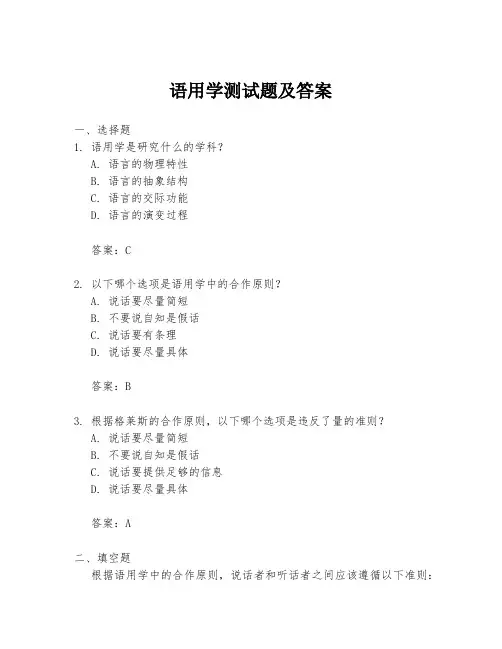
语用学测试题及答案一、选择题1. 语用学是研究什么的学科?A. 语言的物理特性B. 语言的抽象结构C. 语言的交际功能D. 语言的演变过程答案:C2. 以下哪个选项是语用学中的合作原则?A. 说话要尽量简短B. 不要说自知是假话C. 说话要有条理D. 说话要尽量具体答案:B3. 根据格莱斯的合作原则,以下哪个选项是违反了量的准则?A. 说话要尽量简短B. 不要说自知是假话C. 说话要提供足够的信息D. 说话要尽量具体答案:A二、填空题根据语用学中的合作原则,说话者和听话者之间应该遵循以下准则:1. 量的准则:说话者应提供足够的信息,但不要提供比必要更多的信息。
2. 质的准则:说话者不应说自知是假的话,不应说缺乏足够证据的话。
3. 关系准则:说话者应保持话题相关性。
4. 方式准则:说话者应避免模糊不清,避免不明确的表达。
三、简答题1. 请简述语用学中的言外行为理论。
答案:言外行为理论是语用学中的一个重要概念,它指的是说话者通过言语行为所表达的超出字面意义的信息。
言外行为通常包括直接言外行为、间接言外行为和隐喻言外行为等。
2. 举例说明如何通过语境来理解话语的隐含意义。
答案:语境在理解话语的隐含意义中起着至关重要的作用。
例如,当某人在餐厅说“这里的菜真好吃”,在不同的语境下可能有不同的隐含意义。
如果说话者刚刚品尝了一道新菜,这可能是对菜品的直接赞美;但如果餐厅的菜品普遍不佳,这句话可能隐含着讽刺的意味。
四、论述题1. 论述语用学在跨文化交际中的重要性。
答案:语用学在跨文化交际中的重要性体现在多个方面。
首先,不同文化背景的人在交际中可能有不同的语言习惯和交际准则,了解这些差异有助于避免误解和冲突。
其次,语用学可以帮助人们更好地理解言外之意,即通过语境来解读话语的隐含意义。
此外,语用学还有助于提高跨文化交际的效率和效果,通过适当的言语行为来实现交际目的。
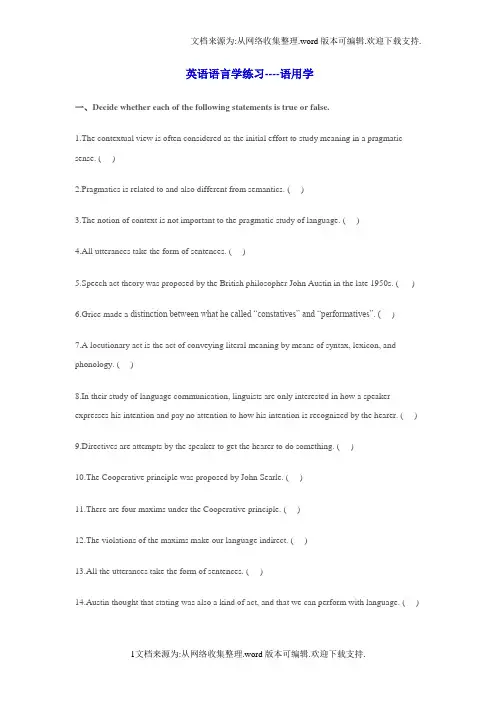
英语语言学练习----语用学一、Decide whether each of the following statements is true or false.1.The contextual view is often considered as the initial effort to study meaning in a pragmatic sense. ( )2.Pragmatics is related to and also different from semantics. ( )3.The notion of context is not important to the pragmatic study of language. ( )4.All utterances take the form of sentences. ( )5.Speech act theory was proposed by the British philosopher John Austin in the late 1950s. ( )6.Grice made a distinction between what he called “constatives” and “performatives”. ()7.A locutionary act is the act of conveying literal meaning by means of syntax, lexicon, and phonology. ( )8.In their study of language communication, linguists are only interested in how a speaker expresses his intention and pay no attention to how his intention is recognized by the hearer. ( )9.Directives are attempts by the speaker to get the hearer to do something. ( )10.The Cooperative principle was proposed by John Searle. ( )11.There are four maxims under the Cooperative principle. ( )12.The violations of the maxims make our language indirect. ( )13.All the utterances take the form of sentences. ( )14.Austin thought that stating was also a kind of act, and that we can perform with language. ( )15.According to the speech act theory, when we are speaking a language, we are doing something, or in other words performing acts; and the process of linguistic communication consists of a sequence of acts. ( )16.All the acts that belong to the same category act share the same purpose or the same illocutionary act, and they are the same in their strength or force. ( )17.All the utterances that can be made to serve the same purpose may vary in the syntactic form. ( )18.Conversation participants nearly always observe the CP and the maxims of the CP. ( )19.A sentence is grammatical concept, and the meaning of a sentence is often studied as the abstract intrinsic property of the sentence itself in terms of a predication. ( )20.Utterance is based on sentence meaning, it is the realization of the abstract meaning of a sentence in a real situation of communication or simply in a context. ( )21.As the process of communication is essentially a process of conveying meaning in a certain context, pragmatics can also be regarded as a kind of meaning study. ( )22.Gradually linguists found that it would be impossible to give an adequate description of meaning if the context of language use was left considered.23.What essentially distinguishes semantics and pragmatics is whether in the study of meaning the context of use is considered. ( )24.Without the shared knowledge both by the speaker and the hearer, linguistic communication would not be possible, and without considering such knowledge, linguistic communication cannot be satisfactorily accounted for in a semantic sense. ( )25.An perlocutionary act is the act of expressing the speaker’s intention. ()26.According to Paul Grice’s ide a, in making conversation, the participants must first of all be willing to cooperate, otherwise, it would not be possible for them to carry on the talk. ( )27.An illocutionary act is the consequence of or the change brought about by the utterance.【Keys】:1. T2. T3.F4.F5.T6.F7.T8.F9.T 10.F11. T 12.T 13.F 14.T 15.T 16. F 17. T 18.F 19.T 20.T21. T 22.F 23.T 24.F 25.F 26. T 27. F二、Fill each of following blanks with one word which begins with the letter given.1. The shared knowledge which constitutes context is of two types; the knowledge of thel________ they use, and the knowledge about the w_______, including the general knowledge about the world and specific knowledge about the situation in which linguistic communication is taking place.2. If we think of a sentence as what people actually utter in the course of communication, it becomes an u________, and it should be considered in the situation in which it is actually used.3. The idea of Paul Grice is that in making conversation, the participants must first of all be willing to c_______, otherwise, it would be impossible for them to carry on the talk. The general principle is called the c________ p_________, abbreviated as CP.4. There are four maxims under the CP: the maxim of quantity, the maxim of q_________, the maxim of relation and the maxim of m____________.5. The maxim of relation requires that what the conversation participants say must ber__________.6. As the process of communication is essentially a process of conveying meaning in a certain context, p__________ can be regarded as a kind of meaning study.7. If c___________ is not considered, the study of meaning is restricted to the area of traditional semantics.8. The meaning of an u__________ is concrete and context-dependent.9. An i___________ act is the act of expressing the speaker’s intention.10. According to Seale, s__________acts fall into five general categories.11. C__________ are those speech acts whose point is to commit the speaker to some future course of action.12. To ask someone to pass a book is obviously a d__________.13. According to Paul Grice, in making c__________ the participants must first of all be willing to cooperate.14. Most of the violations of the four maxims give rise to c___________ implicatures.15. The significance of Grice’s c___________ principle lies in that it explains how it is possible for the speaker to convey more than is literally said.【Keys】:1. language, word2. utterance3. cooperate, Cooperative Principle4. quality,mannar 5. relevant6. pragmatics7. context8. utterance9. illocutionary 10. speech 11. Commissive 12. dirextive 13.conversation 14. conversational15. Cooperative三、There are four choices following each statement. Mark the choice that can best complete the statement.1. __________ resulted mainly from the eapansion of the study of linguistics, especially that of semantics.A. PragmaticsB. PragmatismC. PhonologyD. Practicalism2. Once the notion of _________ was taken into consideration, semantics spiiled into pragmatics.A. meaningB. contextC. formD. content3. If a sentence is regarded as what people actually utter in the course of communication, it becomes _______.A. a sentenceB. an actC. a unitD. an utterance4. A ___________ analysis of an utterance will reveal what the speaker intends to do with it.A. semanticB. syntacticC. pragmaticD. grammatical5. _______ act theory is an important theory in the pragmatic study of language.A. SpeakingB. SpeechC. SoundD. Spoken6. ______ act is the act performed by or resulting from saying something.A. A locutionaryB. An illocutionaryC. A perlocutionaryD. A speech7. One of the contributions Searle has made is his classification of __________ acts.A. locutionaryB. illocutionaryC. perlocutionaryD. speech8. The illocutionary point of __________ is to express the psychological state specified in the utterance.A. directivesB. commisivesC. expressivesD. declarations9. All the utterance that can be made to serve the same purpose may vary in their _________ form.A. syntacticB. semanticC. grammaticalD. pragmatic10. The cooperative Principle is proposed by ________.A. John SearleB. John AustinC. Paul GriceD. John Lyons11. Linguists found that it would be impossible to give an adequate description of meaning if the ________ of language use was left unconsidered.A. brevityB. contextC. accuracyD. none of the above12. Of the three speech acts, linguistic are most interested in the _________.A. locutionary actB. perlocutionary actC. illocutionary actD. none of the above13. The maxim of quantity requires: ___________.A. make your contribution ad informative as required.B. Do not make contribution more informative than is required.C. Do not say that for which you lack adequate evidence.D. Both A and B.14. The maxim of quality requireds: do not say what you believe to be ________.A. falseB. trueC. briefD. orderly15. Most of the violations of the maxims of the CP give rise to _______.A. utterance meaningB. speech act theoryC. conversational implicaturesD. all of the above.16. The significance of Grice’s CP lies in that it explains how it is possible for the speaker to convey _________ is literally said.A. more thanB. less thanC. the same asD. none of the above.【Keys】:1. A2. B3. D4. C5. B6. C7. B8. C9. A 10. C 11. B 12. C 13.D 14. A 15. C 16. A四、Define the following terms.1. context2. utterance meaning3. locutionary act4. illocutionary act5. perlocutionary act【Keys】:1. Context is regarded as constituted by all kinds of knowledge assumed to be shared by the speaker and the hearer.2. Utterance meaning is the realization of the abstract meaning of a sentence in a real situation of communication, or simply in a context; it is concrete and dependent on the context.3. A locutionary act is the act of uttering words, phrases, and clauses. It is the act of conveying literal meaning by means of syntax, lexicon and phonology.4. An illocutionary act is the act of expressing the speaker’s intention; it is the act performed in saying something.5. A perlocuionary act is the act performed or resulting from saying something; it is the consequence of, or resulting saying something.。
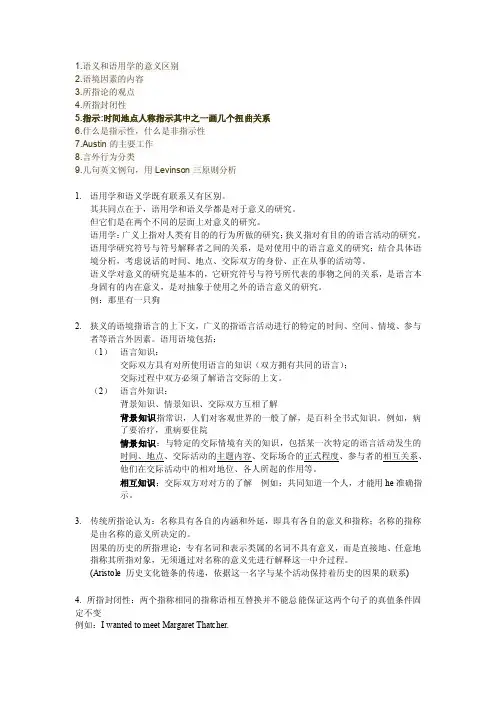
1.语义和语用学的意义区别2.语境因素的内容3.所指论的观点4.所指封闭性5.指示:时间地点人称指示其中之一画几个扭曲关系6.什么是指示性,什么是非指示性7.Austin的主要工作8.言外行为分类9.几句英文例句,用Levinson三原则分析1.语用学和语义学既有联系又有区别。
其共同点在于,语用学和语义学都是对于意义的研究。
但它们是在两个不同的层面上对意义的研究。
语用学:广义上指对人类有目的的行为所做的研究;狭义指对有目的的语言活动的研究。
语用学研究符号与符号解释者之间的关系,是对使用中的语言意义的研究;结合具体语境分析,考虑说话的时间、地点、交际双方的身份、正在从事的活动等。
语义学对意义的研究是基本的,它研究符号与符号所代表的事物之间的关系,是语言本身固有的内在意义,是对抽象于使用之外的语言意义的研究。
例:那里有一只狗2.狭义的语境指语言的上下文,广义的指语言活动进行的特定的时间、空间、情境、参与者等语言外因素。
语用语境包括:(1)语言知识:交际双方具有对所使用语言的知识(双方拥有共同的语言);交际过程中双方必须了解语言交际的上文。
(2)语言外知识:背景知识、情景知识、交际双方互相了解背景知识指常识,人们对客观世界的一般了解,是百科全书式知识。
例如,病了要治疗,重病要住院情景知识:与特定的交际情境有关的知识,包括某一次特定的语言活动发生的时间、地点、交际活动的主题内容、交际场合的正式程度、参与者的相互关系、他们在交际活动中的相对地位、各人所起的作用等。
相互知识:交际双方对对方的了解例如:共同知道一个人,才能用he准确指示。
3.传统所指论认为:名称具有各自的内涵和外延,即具有各自的意义和指称;名称的指称是由名称的意义所决定的。
因果的历史的所指理论:专有名词和表示类属的名词不具有意义,而是直接地、任意地指称其所指对象,无须通过对名称的意义先进行解释这一中介过程。
(Aristole 历史文化链条的传递,依据这一名字与某个活动保持着历史的因果的联系)4. 所指封闭性:两个指称相同的指称语相互替换并不能总能保证这两个句子的真值条件固定不变例如:I wanted to meet Margaret Thatcher.I wanted to meet the first woman Prime Minister of Great Britain.因为专有名词重名,确定性描述语有指称性和归属性两种用法等因素。
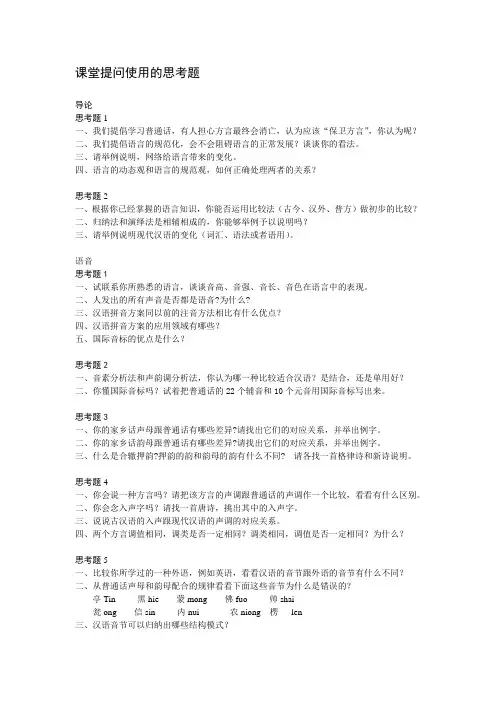
课堂提问使用的思考题导论思考题1一、我们提倡学习普通话,有人担心方言最终会消亡,认为应该“保卫方言”,你认为呢?二、我们提倡语言的规范化,会不会阻碍语言的正常发展?谈谈你的看法。
三、请举例说明,网络给语言带来的变化。
四、语言的动态观和语言的规范观,如何正确处理两者的关系?思考题2一、根据你已经掌握的语言知识,你能否运用比较法(古今、汉外、普方)做初步的比较?二、归纳法和演绎法是相辅相成的,你能够举例予以说明吗?三、请举例说明现代汉语的变化(词汇、语法或者语用)。
语音思考题1一、试联系你所熟悉的语言,谈谈音高、音强、音长、音色在语言中的表现。
二、人发出的所有声音是否都是语音?为什么?三、汉语拼音方案同以前的注音方法相比有什么优点?四、汉语拼音方案的应用领域有哪些?五、国际音标的优点是什么?思考题2一、音素分析法和声韵调分析法,你认为哪一种比较适合汉语?是结合,还是单用好?二、你懂国际音标吗?试着把普通话的22个辅音和10个元音用国际音标写出来。
思考题3一、你的家乡话声母跟普通话有哪些差异?请找出它们的对应关系,并举出例字。
二、你的家乡话韵母跟普通话有哪些差异?请找出它们的对应关系,并举出例字。
三、什么是合辙押韵?押韵的韵和韵母的韵有什么不同?请各找一首格律诗和新诗说明。
思考题4一、你会说一种方言吗?请把该方言的声调跟普通话的声调作一个比较,看看有什么区别。
二、你会念入声字吗?请找一首唐诗,挑出其中的入声字。
三、说说古汉语的入声跟现代汉语的声调的对应关系。
四、两个方言调值相同,调类是否一定相同?调类相同,调值是否一定相同?为什么?思考题5一、比较你所学过的一种外语,例如英语,看看汉语的音节跟外语的音节有什么不同?二、从普通话声母和韵母配合的规律看看下面这些音节为什么是错误的?亭Tin 黑hie 蒙mong 佛fuo 帅shai瓮ong 信sin 内nui 农niong 楞len三、汉语音节可以归纳出哪些结构模式?四、普通话语音教学,你认为哪种办法比较有效?成人教学和小学教学如何区别?思考题6一、[i]、[ ɿ]、[ʅ ]有人归纳为一个音位,有人归纳为三个音位,有人归纳为两个音位,这样处理各有什么理由?谈谈你自己的看法。
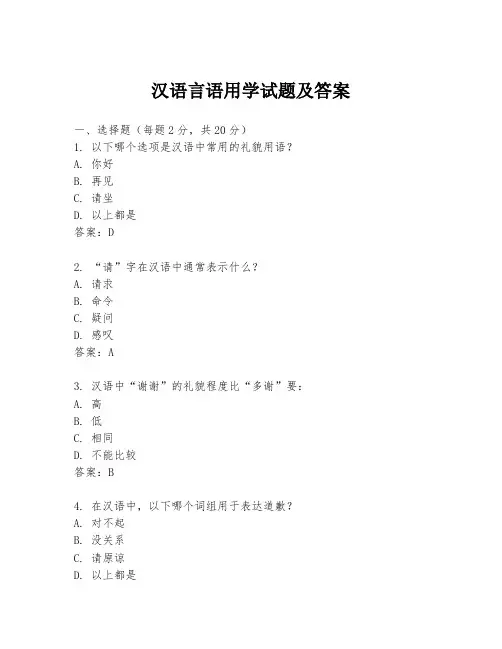
汉语言语用学试题及答案一、选择题(每题2分,共20分)1. 以下哪个选项是汉语中常用的礼貌用语?A. 你好B. 再见C. 请坐D. 以上都是答案:D2. “请”字在汉语中通常表示什么?A. 请求B. 命令C. 疑问D. 感叹答案:A3. 汉语中“谢谢”的礼貌程度比“多谢”要:A. 高B. 低C. 相同D. 不能比较答案:B4. 在汉语中,以下哪个词组用于表达道歉?A. 对不起B. 没关系C. 请原谅D. 以上都是5. 汉语中“请稍等”的意思是:A. 请等待B. 请离开C. 请快点D. 请坐下答案:A6. 汉语中“打扰一下”通常用于:A. 表示不满B. 表示请求C. 表示感谢D. 表示道歉答案:B7. 在汉语中,“请问”一词通常用于:A. 开始提问B. 结束提问C. 表示命令D. 表示拒绝答案:A8. 汉语中“请慢用”通常用于:A. 用餐时B. 工作时C. 学习时D. 睡觉时答案:A9. 在汉语中,“请多指教”通常用于:B. 工作时C. 用餐时D. 睡觉时答案:B10. 汉语中“请稍候”的意思是:A. 请等待B. 请离开C. 请快点D. 请坐下答案:A二、填空题(每题2分,共20分)1. 汉语中表示“请慢走”的礼貌用语是“________”。
答案:请慢走2. 汉语中表示“请稍等”的礼貌用语是“________”。
答案:请稍等3. 在汉语中,当需要别人让路时,可以说“________”。
答案:借过4. 汉语中表示“请坐”的礼貌用语是“________”。
答案:请坐5. 汉语中表示“请稍候”的礼貌用语是“________”。
答案:请稍候6. 汉语中表示“请多指教”的礼貌用语是“________”。
答案:请多指教7. 在汉语中,当需要别人帮助时,可以说“________”。
答案:请帮忙8. 汉语中表示“请原谅”的礼貌用语是“________”。
答案:请原谅9. 在汉语中,当需要别人让座时,可以说“________”。

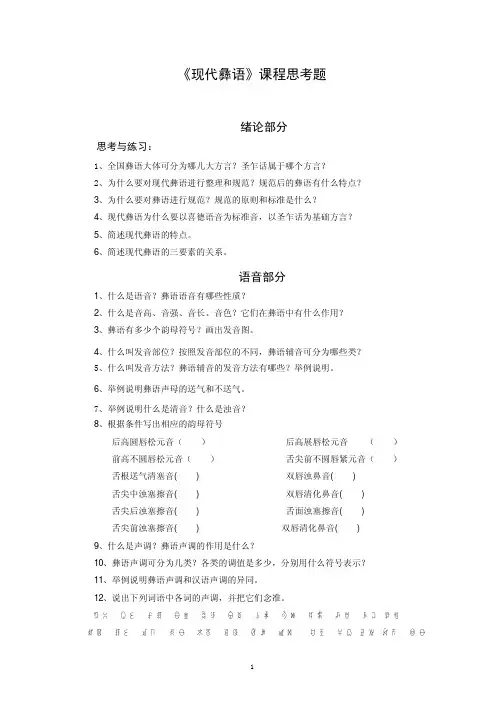
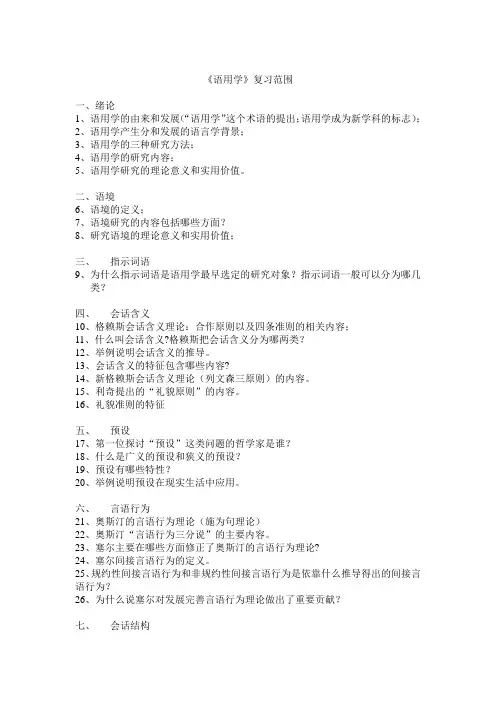
《语用学》复习范围一、绪论1、语用学的由来和发展(“语用学”这个术语的提出;语用学成为新学科的标志);2、语用学产生分和发展的语言学背景;3、语用学的三种研究方法;4、语用学的研究内容;5、语用学研究的理论意义和实用价值。
二、语境6、语境的定义;7、语境研究的内容包括哪些方面?8、研究语境的理论意义和实用价值;三、指示词语9、为什么指示词语是语用学最早选定的研究对象?指示词语一般可以分为哪几类?四、会话含义10、格赖斯会话含义理论:合作原则以及四条准则的相关内容;11、什么叫会话含义?格赖斯把会话含义分为哪两类?12、举例说明会话含义的推导。
13、会话含义的特征包含哪些内容?14、新格赖斯会话含义理论(列文森三原则)的内容。
15、利奇提出的“礼貌原则”的内容。
16、礼貌准则的特征五、预设17、第一位探讨“预设”这类问题的哲学家是谁?18、什么是广义的预设和狭义的预设?19、预设有哪些特性?20、举例说明预设在现实生活中应用。
六、言语行为21、奥斯汀的言语行为理论(施为句理论)22、奥斯汀“言语行为三分说”的主要内容。
23、塞尔主要在哪些方面修正了奥斯汀的言语行为理论?24、塞尔间接言语行为的定义。
25、规约性间接言语行为和非规约性间接言语行为是依靠什么推导得出的间接言语行为?26、为什么说塞尔对发展完善言语行为理论做出了重要贡献?七、会话结构27、语用学为什么要研究会话结构?、28、会话结构所涉及的几个概念:A、轮流说话B、相邻对C、修正机制D、预示序列E、总体结构(开端、本体、结束语)考试题型:一、填空题:(每空1分,共10分)二、名词解释(4个,每个5分,共20分)三、简答题(4题,每题10分,共40分)四、分析题(2题,每题15分,共30分)。
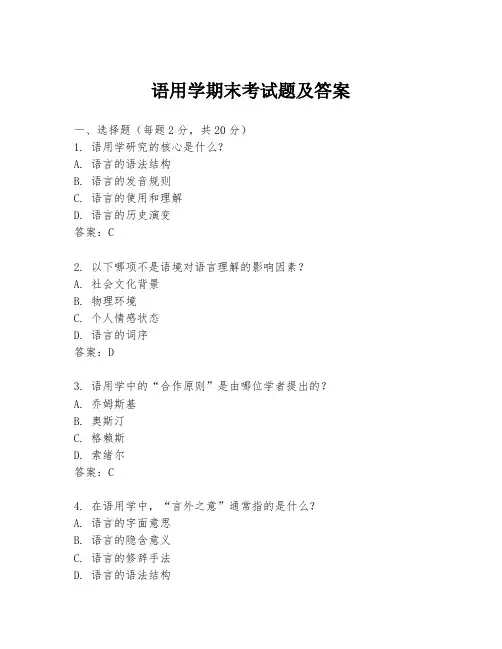
语用学期末考试题及答案一、选择题(每题2分,共20分)1. 语用学研究的核心是什么?A. 语言的语法结构B. 语言的发音规则C. 语言的使用和理解D. 语言的历史演变答案:C2. 以下哪项不是语境对语言理解的影响因素?A. 社会文化背景B. 物理环境C. 个人情感状态D. 语言的词序答案:D3. 语用学中的“合作原则”是由哪位学者提出的?A. 乔姆斯基B. 奥斯汀C. 格赖斯D. 索绪尔答案:C4. 在语用学中,“言外之意”通常指的是什么?A. 语言的字面意思B. 语言的隐含意义C. 语言的修辞手法D. 语言的语法结构答案:B5. 以下哪个选项不是语用学中的言语行为?A. 陈述B. 命令C. 询问D. 描述答案:D6. 语用学中的“礼貌原则”是由哪位学者提出的?A. 布朗和莱文森B. 格赖斯C. 奥斯汀D. 索绪尔答案:A7. 在语用学中,如何理解“语境”这一概念?A. 仅指语言使用的物理环境B. 仅指语言使用的社交环境C. 包括语言使用的物理环境和社交环境D. 仅指语言使用的文化环境答案:C8. 以下哪项不是语用学中的话语分析方法?A. 话语连贯性分析B. 话语结构分析C. 话语主题分析D. 语法结构分析答案:D9. 语用学中的“指示语”主要指的是什么?A. 指示时间的词语B. 指示地点的词语C. 指示说话人和听话人关系的词语D. 指示说话人和听话人身份的词语答案:C10. 在语用学中,如何理解“隐喻”这一概念?A. 一种修辞手法B. 一种语言错误C. 一种逻辑推理D. 一种语法结构答案:A二、简答题(每题5分,共30分)1. 简述语用学与语义学的主要区别。
答:语用学主要研究语言的使用和理解,关注语境对语言的影响,而语义学则关注语言的意义和结构。
2. 描述格赖斯的“合作原则”包含哪些准则。
答:合作原则包含四个准则:数量准则、质量准则、关联准则和方式准则。
3. 解释“礼貌原则”在交际中的作用。
答:礼貌原则指导人们在交际中遵循一定的规范,以减少冲突,维护和谐的社交关系。
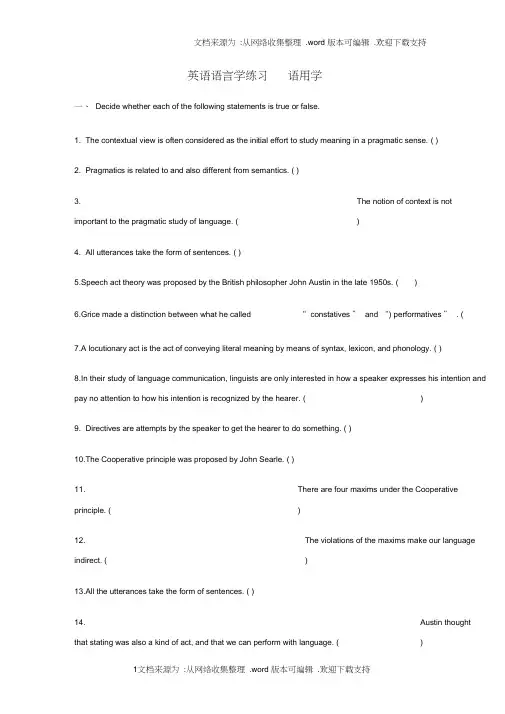
英语语言学练习语用学一、Decide whether each of the following statements is true or false.1. The contextual view is often considered as the initial effort to study meaning in a pragmatic sense. ( )2. Pragmatics is related to and also different from semantics. ( )3. The notion of context is not important to the pragmatic study of language. ( )4. All utterances take the form of sentences. ( )5.Speech act theory was proposed by the British philosopher John Austin in the late 1950s. ( )6.Grice made a distinction between what he called “ constatives ” and “) performatives ” . (7.A locutionary act is the act of conveying literal meaning by means of syntax, lexicon, and phonology. ( )8.In their study of language communication, linguists are only interested in how a speaker expresses his intention and pay no attention to how his intention is recognized by the hearer. ( )9. Directives are attempts by the speaker to get the hearer to do something. ( )10. T he Cooperative principle was proposed by John Searle. ( )11. There are four maxims under the Cooperative principle. ( )12. The violations of the maxims make our language indirect. ( )13. A ll the utterances take the form of sentences. ( )14. Austin thought that stating was also a kind of act, and that we can perform with language. ( )15. A ccording to the speech act theory, when we are speaking a language, we are doing something, or in other words performing acts; and the process of linguistic communication consists of a sequence of acts. ( )16. All the acts that belong to the same category act share the same purpose or the same illocutionary act, and they are the same in their strength or force. ( )17. A ll the utterances that can be made to serve the same purpose may vary in the syntactic form. ( )18. Conversation participants nearly always observe the CP and the maxims of the CP. ( )19. A sentence is grammatical concept, and the meaning of a sentence is often studied as the abstract intrinsic property of the sentence itself in terms of a predication. ( )20. Utterance is based on sentence meaning, it is the realization of the abstract meaning of a sentence in a real situation of communication or simply in a context. ()21. A s the process of communication is essentially a process of conveying meaning in a certain context, pragmatics can also be regarded as a kind of meaning study. ( )22. G radually linguists found that it would be impossible to give an adequate description of meaning if the context of language use was left considered.23. W hat essentially distinguishes semantics and pragmatics is whether in the study of meaning the context of use is considered. ( )24. W ithout the shared knowledge both by the speaker and the hearer, linguistic communication would not be possible, and without considering such knowledge, linguistic communication cannot be satisfactorily accounted for ina semantic sense. ( )25. An perlocutionary act is the act of expressing the speaker ) ' s intention. (26. According to Paul Grice a, 'in ms iadkeing conversation, the participants must first of all bewilling to cooperate, otherwise, it would not be possible for them to carry on the talk. ( )27. A n illocutionary act is the consequence of or the change brought about by the utterance.【Keys】:1. T2. T3.F4.F5.T6.F7.T8.F9.T 10.F11. T 12.T 13.F 14.T 15.T 16. F 17. T 18.F 19.T 20.T21. T 22.F 23.T 24.F 25.F 26. T 27. F二、Fill each of following blanks with one word which begins with the letter given.1. The shared knowledge which constitutes context is of two types; the knowledge of thel _______ they use, and the knowledge about the w _____ , including the general knowledgeabout the world and specific knowledge about the situation in which linguistic communication is taking place.2. If we think of a sentence as what people actually utter in the course of communication, it becomes an u , and it should be considered in the situation in which it is actually used.3. The idea of Paul Grice is that in making conversation, the participants must first of all be willing to c , otherwise, it would be impossible for them to carry on the talk. The generalprinciple is called the c _______ p _______ , abbreviated as CP.4. There are four maxims under the CP: the maxim of quantity, the maxim of q _______ , themaxim of relation and the maxim of m __________ .5. The maxim of relation requires that what the conversation participants say must be r .6. As the process of communication is essentially a process of conveying meaning in a certain context, p can be regarded as a kind of meaning study.7. If c __________ is not considered, the study of meaning is restricted to the area of traditionalsemantics.8. The meaning of an u ________ is concrete and context-dependent.9. An i _________ act is the act of expressing the speaker ' s intention.10. According to Seale, s ________ acts fall into five general categories.11. C ________ are those speech acts whose point is to commit the speaker to some futurecourse of action.12. To ask someone to pass a book is obviously a d ________ .13. According to Paul Grice, in making c ________ the participants must first of all be willing to cooperate.14. Most of the violations of the four maxims give rise to c __________ implicatures.15. The significance of Grice ' s c ___________ principle lies in that it explains how it is possible for the speaker to convey more than is literally said.【Keys 】:1. language, word2. utterance3. cooperate, Cooperative Principle4. quality,mannar 5. relevant6. pragmatics7. context8. utterance9. illocutionary 10. speech 11. Commissive 12. dirextive 13.conversation 14. conversational15. Cooperative三、There are four choices following each statement. Mark the choice that can best complete the statement.1. _________ resulted mainly from the eapansion of the study of linguistics, especially that ofsemantics.A. PragmaticsB. PragmatismC. PhonologyD. Practicalism2. Once the notion of _______ was taken into consideration, semantics spiiled into pragmatics.A. meaningB. contextC. formD. content3. If a sentence is regarded as what people actually utter in the course of communication, it becomes .A. a sentenceB. an actC. a unitD. an utterance4. A _________ analysis of an utterance will reveal what the speaker intends to do with it.A. semanticB. syntacticC. pragmaticD. grammatical5. _____ act theory is an important theory in the pragmatic study of language.A. SpeakingB. SpeechC. SoundD. Spoken6. ____ act is the act performed by or resulting from saying something.A. A locutionaryB. An illocutionaryC. A perlocutionaryD. A speech7. One of the contributions Searle has made is his classification of ________ acts.A. locutionaryB. illocutionaryC. perlocutionaryD. speech8. The illocutionary point of ________ is to express the psychological state specified in the utterance.A. directivesB. commisivesC. expressivesD. declarations9. All the utterance that can be made to serve the same purpose may vary in their _______ form.A. syntacticB. semanticC. grammaticalD. pragmatic10. The cooperative Principle is proposed by _____ .A. John SearleB. John AustinC. Paul GriceD. John Lyons11. Linguists found that it would be impossible to give an adequate description of meaning if the_______ of language use was left unconsidered.A. brevityB. contextC. accuracyD. none of the above12. Of the three speech acts, linguistic are most interested in the _______ .A. locutionary actB. perlocutionary actC. illocutionary actD. none of the above13. The maxim of quantity requires: _________ .A. make your contribution ad informative as required.B. Do not make contribution more informative than is required.C. Do not say that for which you lack adequate evidence.D. Both A and B.14. The maxim of quality requireds: do not say what you believe to be ______ .A. falseB. trueC. briefD. orderly15. Most of the violations of the maxims of the CP give rise to _____ .A. utterance meaningB. speech act theoryC. conversational implicaturesD. all of the above.16. The significance of Grice ' s CP lies in that it explains how it is possible for the speaker to convey ________ is literally said.A. more thanB. less thanC. the same asD. none of the above.【Keys 】:1. A2. B3. D4. C5. B6. C7. B8. C9. A 10. C 11. B 12. C 13.D 14. A 15. C 16. A四、Define the following terms.1. context2. utterance meaning3. locutionary act4. illocutionary act5. perlocutionary act【Keys 】:1. Context is regarded as constituted by all kinds of knowledge assumed to be shared by the speaker and the hearer.2. Utterance meaning is the realization of the abstract meaning of a sentence in a real situation of communication, or simply in a context; it is concrete and dependent on the context.3. A locutionary act is the act of uttering words, phrases, and clauses. It is the act of conveying literal meaning by means of syntax, lexicon and phonology.4. An illocutionary act is the act of expressing the speaker saying something.s intention; it is the act performed in 5. A perlocuionary act is the act performed or resulting from saying something; it is the consequence of, or resulting saying something.。
第一章 1、什么是语用学?它探索的主要现象有哪些?主要有哪些理论?P14 定义: 语用学,即语言使用的实用学。 语用学,研究在不同语境中话语意义的恰当地表达和准确地理解,寻找并确立使话语意义得以恰当地表达和准确地理解的基本原则和准则。 语用学,研究话语在使用中的语境意义,或话语在特定语境条件下的交际意义,特别研究在不同的语言交际环境下如何准确地理解语言和恰当地运用语言。 2、字面意义和语境意义有何区别?请举例说明?
1)今天是星期天。 句子的字面意义: 一个判断,说话人说话的当天是一个星期七天中的第一天。 话语的语境意义: ①妻子对伏案工作的丈夫说此语,意思是建议他好好休息。 ②妻子对答应星期天帮她作家务活的丈夫说此语,意思是提醒丈夫快去作家务。 ③想去春游的儿子对让他在家复习的妈妈说此语,意思是请求或建议他妈妈带她去玩或者同意他去玩 3、语用学和语言学的其他分支学科是什么关系?P8-9
对于语用学和语言学的其他分支学科的关系,学者有明显不同的看法。我们赞同D种看法:语言学是由语言系统研究(音系学、词法学、句法学、语义学)和语言使用研究(语用学)两个子系统构成的,语用学是语言学的一个分支,是研究语言的使用。 4、语用学有哪三类研究方法?P15
A、纯语用学:研究语用学的形式和范畴。 B、描写语用学:对一种语言与情景结合而出现的种种用法加以描写,即描写人们来自经验的有关自然语言的应用原则,分析自然语言如何同语境相联系。 C、应用语用学:与应用语言学诸方面结合的研究,特别是外语教学、人-机对话和人工智能,以及不同语言之间的语用对比研究。 5、语用学的研究内容主要包括哪些方面?P16
第二章 1、什么是语境?P教材22 定义:语境就是人们运用自然语言进行言语交际的言语环境。 语境就是任何与语言形式出现相关的环境要素构成的集合 2、波兰籍人类语言学家马林诺夫斯把语境分为哪两类?
P18文化语境和情景语境 3、“伦敦学派”的创始人弗思提出了什么语境理论?P19
4、索振羽主张语境要研究哪些内容?P23 5、研究语境有何理论意义和实用意义?P37 第三章
1、英语“deixis“有哪些汉译?应该翻译成什么比较确切? 语用学者有人译作“指示词语”,有人译作“指别”。我们认为应译为“指示词语及其功能”才比较确切。 2、什么是指示语和指示信息?
指示词语:也称指示语,就是表示指示信息的词语。即巴尔-希勒尔所谓的“在不知其使用语境时就无法确定其所指语义的指示词或指示句。”(见教材第39页) 指示信息:就是指示词语所表达的指称意义或者隐含意义。包括人称、时间、空间、移动等概念;也指话语进程、会话双方相互识别及相互关系等。 3、指示语包括哪些主要类别?各类指示语在话语中传达什么样的指示
信息?P42 4、举例说明是地点指示语的手势用法。
③把这本书拿到那里去,把那本书拿到这里来。 “这里”、“那里”的地点所指,没有语境是不明确的。如果说话人在说此话语时以其所处的位置为基准,借助于手势向听话人指点方位或位置,那么听话人就能准确判定它们的地点所指。 5、为什么说“我们”这一第一人称指示语也具有社交指示语的双重交
际功能?举例以说明。 例如:老师:谢小凤同学今天做了一件好事,我们问一下她,你当时是怎么想的? 有了特定语境则指说话人。“我们”具有社交指示语的功能,使用它,实指老师本人,等于“我”,而非表复指,但“我们”具有语用移情的社交指示功能,可以缩短说话人(教师)与听话人(学生们)之间在现时语境中的社交距离,或改善社交关系等,进而有助于顺利推进言语交际。因此“我们”这一人称指示语也具有社交指示语的双重交际功能。 6、举例说明“来”和“去”的内在指示意义。
⑤进来吧! 我们以后再到海南岛去。 咱们过去吧! 我们过来吧! 趋向动词“来”和“去”的地点指示都是移动行为的目的地,但具有不同的方位指示。如果不知道说话人所在地,就不知道发出这类动作的人是说话人、听话人,还是第三者;不了解目的地与地点指示的关系,即目的地是说话人所在地、听话人所在地,还是第三者所在地。 7、照应和指别有何区别?P41
指别是指示语依赖各种语境的指称,而照应因在语言语境中已预设了指称对象,所以是不再需要依赖上下文以外的语境的指称(有人称为“非指别的指称”) 8、举例说明第三人称代词既有照应功能,又有指别功能。
①他去了新疆,那边有很多少数民族,我交了不少少数民族朋友。 ②那边有很多少数民族,我交了不少少数民族朋友。 例①中的“那边”既起指别作用,又起照应作用。例②中的“那边”只起指别作用,不起照应作用。 第四章 1、什么叫会话含义?为什么要研究会话含义?P58 会话含义:就是话语在会话中产生的隐含意义,即说话者的“言外之意”,也就是语用含义 2、试解释格赖斯“会话含义”学说的合作原则。P56 指在参与交谈时,要使你说的话符合你所参与的交谈的双方(或各方)公认目的或方向。 格赖斯认为,人们的正常语言交流不是一系列毫无联系的话语的组合,说话人是互相合作的。对话的双方(或各方)有着共同的目的,最起码有着互相接受的方向。为了达此目的,对话的各方就要共同遵守一个原则:使自己的话语符合各方共同目的的需要。格赖斯称这一原则为“合作原则。” 3、格赖斯总结出哪四种可能不遵守这些准则的情况?各举一例说明P57 4、会话含义可分那些类别?P58、59 5、举例说明“会话含义”的特征。P69 6、莱文森提出了哪三条会话含义原则?古典格赖斯理论和新格赖斯理论的区别?P74 7、什么是礼貌原则?P90六条准则 8、在言语交际中如何才显得礼貌得体?P91次准则 第五章 思考与分析
一、什么叫预设?试举一例并加以说明。 预设(presupposition),或译为“前提”、“先设”。广义的预设,指交际双方预先设定的信息,即说话和写作时假定对方已知的信息。狭义的预设,是在句义中体现出或暗含着的某些客观事态、情况。 甲:你怎么迟到了? 乙:我的自行车给偷走了。 乙的这句话有如下预设:1、存在一种叫自行车的车子;2、乙有自行车。否则乙就不会对甲说这句话,这句话也不能成为乙解释为什么迟到的理由,甲也无从推导出它的含义。二者同为存在性预设。 二、预设从内容分有哪两种?预设按照推断的依据分有哪两种?试各举
一例并加以说明。
三、什么是蕴涵?试举一例并加以说明。 蕴涵(entailment)或译“推涵”、“衍推”(教材第128页)。是指两个句子之间的这样一种逻辑关系:第二个句子的真必定取决于第一个句子的真实,即如果第一个句子为真时,第二个句子必真;第一个句子的假必定取决于第二个句子的虚假,即如果第二个句子为假时,第一个句子必假。 举例P128 四、如何区别预设和蕴涵?试举一例并加以说明。P129
五、语用预设有哪两个特征? A、合适性 所谓预设的合适性,就是说预设要与语境紧密结合,预设是言语行为的先决条件。例如: 母亲对女儿说:玛丽,打扫房间! 母亲发出这个言语行为是提出一个“请求”,这个“请求”是否合适,是有一系列语用预设作为先决条件的。比如,请求打扫的房间是母亲和女儿都明确的那个房间;这个房间已经脏了或乱了;母亲还知道女儿有能力做这件事······等等。如果实际的语境并不具备这样的条件,比如,玛丽不知道母亲说的是哪一间房间,或者要求打扫的房间已经很整洁,或者玛丽年纪很小,根本不能胜任这件工作等等。那么,这位母亲的“请求”就毫无意义。 B、共知性 语用预设必须是谈话双方所共知,这是所谓预设的共知性或共同性的问题。 第一种情况:预设往往是谈话双方或一般人共知的信息,它与语境紧密结合。 ①共知预设:久旱无雨。甲:天下雨啦!乙:庄稼可有救啦! 第二种情况:预设的共知性要通过说话人的话语暗示出来,并得到听话人的理解。例如:①甲:赵青开始学英语。》赵青以前没学过英语。乙:你要多帮帮他。 第三种情况:预设的共知性有时只指说话双方的共知事物,第三者如不了解预设而只依靠语境,是不一定能真正理解说话双方对话的内容的。 在一家商店里,顾客甲和售货员乙的一段对话: 甲:来了没有? 乙:还没有呢!我也等得急死了。 甲:快两个月了,会不会出甚么事了? 乙:不会,不会,以前也有过这种情况。甲:但愿如此。 如果甲、乙的关系单纯是买主、卖主的关系,他们可能谈论甲的订货来了没有;如果甲、乙同时又是朋友关系,那么他们可能在谈论他们的—位朋友来了没有,预设是什么,第三者是难以判断的,但甲、乙两人却很清楚。这不但说明预设的共知性,而且说明这种共知性有时只局限于谈话对方。 六、什么叫预设触发语?试举例说明。P130
七、预设在会话中有何用途?
八、试指出下面这些话语的预设: 1、英国女皇又要来访问。 2、张玲的电脑修好了。 3、他今天没有再迟到了。 4、甲:九寨沟的风景太美了,我给你介绍介绍吧! 乙:桌上的鱼香肉丝真好吃。 5、甲:天下雨啦! 乙:这一下没那么热了。
九、判断题: 1、“我出门的时候没带钥匙”和“我出门了”中,哪个语句是“我出门的时候把钥匙忘在家里了”的预设?哪个语句是“我出门的时候把钥匙忘在家里了”的蕴涵?
2、“有种叫麻婆豆腐的菜”、“桌上有麻婆豆腐”、“桌上的麻婆豆腐吃完了”、“说话人吃(或‘尝’)了桌上的麻婆豆腐”和“桌上的麻婆豆腐不好吃”中,哪些语句是“桌上的麻婆豆腐真好吃”的预设?哪些语句是“桌上的麻婆豆腐真好吃”的蕴涵?
第五章 1、什么是施为句和施为动词? 请列举英语和汉语中常见的施为动词。P146 施为句是用来完成某种行为的句子,即“有所为之言”的句子。 在显性施为话语中使用的动词。 举例: